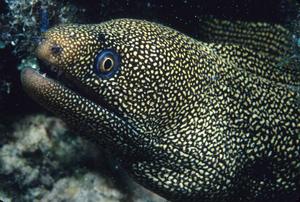

In Bonaire, the goldentail moray (Gymnothorax miliaris) extends its head from openings in the reef during the day, but forages in the open at night. (Photo Dr. Diane Nelson)
GRAY, Tenn. -- Field trips are a great way to enhance students' learning experiences, but because of fewer resources, some school groups are missing an important part of East Tennessee's history.
The "Ocean Gems" calendar is a new fundraising initiative by the East Tennessee State University and General Shale Brick Natural History Museum designed to reach out to schools by providing financial support for student educational trips to the Gray Fossil Site.
More than 300 school groups have toured the fossil site and the ETSU museum since its opening in August 2007. However, for many school districts, museum admission fees and transportation costs sometimes outweigh the value of student participation in the numerous educational experiences being offered.
To help offset these costs, proceeds from the sale of this calendar are contributed to a scholarship fund for schools in the East Tennessee, Southwest Virginia and Western North Carolina regions. The fund will allow students a chance to fully explore the facility and the unique five-acre dig site on which it rests.
This 16-month, full-color calendar showcases the vivid underwater photography of renowned ETSU marine biologist and professor emerita of biological sciences Dr. Diane R. Nelson while reflecting her research with fascinating creatures and their watery environment.
Although no marine fossils have yet been found at the Miocene era Gray Fossil Site, the ocean once covered the entire region and marine fossils have been discovered elsewhere in the area. As Nelson often observes, "We are all connected with the ocean, either directly or indirectly through our lakes, rivers and streams."
The university's Natural History Museum uses a multi-disciplinary approach to foster knowledge about all aspects of natural history, from the mountains to the sea. The "Ocean Gems" calendar highlights marine inhabitants of coral reefs around the world, many endangered due to ocean warming and overfishing.